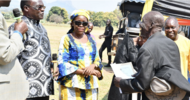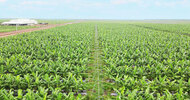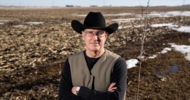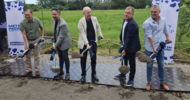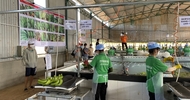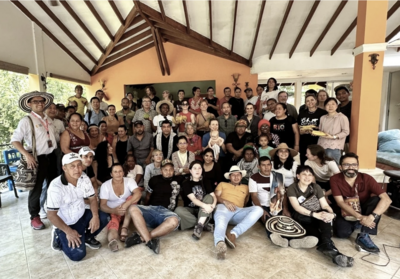
Social movement and academic delegates visit with signatories of the historic Colombian peace agreement on a land plot previously controlled by drug traffickers in the Puerto Salgar municipality; community members also sent a delegation to Bogotá to participate in the International Conference on Global Land Grabbing.
(Photo: @jovieshome)
Common Dreams | 11 April 2024
Five things to know about the global land rush and how to stop it
by Salena Tramel
A recent gathering in Colombia, organized by the Land Deal Politics Initiative, was an important moment to assess the current state of play and ready strategies to face the current and impending onslaught of land grabs.
If one thing is clear coming out of the International Conference on Global Land Grabbing last month in Bogotá, it is that the land rush is here to stay—and it's gaining momentum. The concept of land rush serves as an umbrella for the multidimensional land grabs that occur at different scales. It helps us grasp chaotic and insurgent moments—such as the one now underway—which are pushed forward by multiple actors and often involve violence.
The gathering in Colombia, organized by the Land Deal Politics Initiative, was an important moment to assess the current state of play and ready strategies to face the current and impending onslaught of land grabs. It was a cutting edge convergence of frontline social movement leaders, unapologetically progressive researchers, and policymakers with backgrounds in grassroots organizing—all dedicated to land politics and representing 69 countries.
These efforts come at a critical time, when the media's spotlight on land grabbing has dimmed—signaling that the practice has become a routine part of international politics. The following are five key takeaways from the meeting in Colombia about the state of the land rush and the resistance that seeks to stop it in its tracks.
1. The Old Guard Marches On
Grabbing land, natural resources, and territory has always been an integral part of capitalism. The system thrives on crises—the more, the more profitable—which in turn provoke waves of uneven development. Contemporary land grabs are a layering of these factors, all of which are extractive in nature. When the 2008 food price crisis became ensnarled with global disruptions in finance and energy, it reconfigured large-scale land grabs as the world has come to know them.
Although agribusiness has been a defining feature of decades of neoliberal reforms, it has proliferated even more across the global South in recent years—turning peasant farms and Indigenous forests into monocrop business ventures. A striking case is that of Tanzania, one of the most heavily targeted countries for land grabs 15 years ago. Now it is bracing for a new surge of land deals for mass export crops, made worse by the oppressive seed policies that have been imposed throughout the African continent. These older land deals are on the map to stay, and the situation is further complicated by their newer counterparts.
2. Climate Politics Signify the Perfect Storm
Green and blue grabs—the idea of "selling nature to save it"—masquerade as a solution to the climate crisis and have resulted in an advanced surge of extraction, commodification, and financialization of nature. Such initiatives have brought new actors to the scene of the extractive economy, some of whom initially opposed it, in a vastly complicated alliance.
Cambodia, for instance, was the first country in Southeast Asia to endorse the Blue Skies & Net Zero 2050 campaign, which is one of the latest developments in carbon trading—earlier versions of which have devastated rural communities through massive land, water, and forest grabs. International financial and intergovernmental institutions continue to blame farmers, fishers, and forest dwellers for worsening climate change through "backwards" techniques—when the real culprit is violent foreign intervention coupled with decades of natural resource grabs led by agribusiness. Instead of attacking this problem at its root, programs like Net Zero make promises to resolve hunger, unemployment, and the climate crisis at once. The devil, however, is in the details—in this case shouldering local Cambodian peasants with the burden of mitigating big corporate pollution from abroad, unavoidably leading to more land grabs.
3. Resurging Violent Conflicts and Geopolitics
Land, water, and food have long been weaponized against marginalized populations through extreme violence. While our understanding of contemporary land grabs has often been one of transactionary land deals, usually large in scale, and often synonymous with agribusiness, we have yet to fully incorporate land seizures carried out through military invasions and wars into the equation. We must expand our conceptualization of the land rush to more comprehensively include these factors, also paying attention to the geopolitical environments in which they unfold.
An important link here is that for many peasant and Indigenous populations, land is not only a resource, but also territory. Seeing land grabbing as territory grabbing is a way of coming to terms with how land capture in violent conflict is an abduction of people, movements, culture, and history. As such, it has resounding place-specific and collective implications. Today genocide and ecocide in Gaza as a result of the Israeli invasion have refocused global attention on the question of Palestine. Analyzing these actions as territory grabs may contribute to a more just resolution of violent conflict—not only in Palestine, but also in other militarized geopolitical contexts as diverse as Haiti, Sudan, Myanmar, and Ukraine.
4. Colonization Is Alive and Well
The land rushes that are reproduced to sustain capitalism are held up by intersecting levers of oppression, among them class fragmentation and socially constructed identity politics like race and gender. These forced divisions are the driving force behind past and present colonial projects. Across the Americas, the plantation economy was made possible by the enslaved labor of Black bodies, the removal of Indigenous ones, and the cheapening of female and gender nonconforming ones. Struggles for independence and liberation from these processes have only partially been won, which is illustrated by modern land grabbing as an extension of plantation economies.
Land grabbing feeds on race, class, and gender as overlapping forms of oppression—and as such affects the Global North in addition to the Global South. In the highly racialized context of the United States, agribusiness continues to operate on lands stolen from Indigenous peoples with the labor of undocumented migrants—many of them displaced by extractive activities led by the United States in countries south of its Mexican border.
5. Peasant and Indigenous Movements Lead the Resistance
If anyone knows the true value of land, it is the peasant and Indigenous communities that have ensured its survival across borders and generations. These groups of people are consistently hunted alongside the natural resources they seek to protect. Their demands—for ending and rolling back land grabs—are most often disregarded as idealistic at best and downright undoable at worst.
But against all odds, and frequently faced with great danger, social movements are winning struggles for territory. This work occurs in sophisticated alliances that straddle local, national, and international organizing efforts. Colombia was selected as the host country for the gathering against land grabbing precisely for these reasons, with hopes that bearing witness to the history being written there could inspire political gains elsewhere. From its Pacific and Caribbean coastlines, to its vast farmlands that fade into the Amazonian and Andean forests, rural communities are taking back territory—under the protection of an amenable government that is committed to an ongoing process of putting into place peasant and Indigenous autonomous zones.
Social movements are building strong convergences with politically aligned scholars and policymakers to prepare for the next phases of their still-uphill battle against the land rush—not only in Colombia, but around the world.






